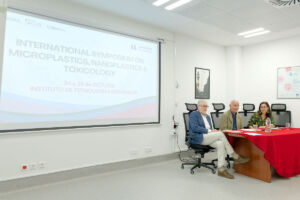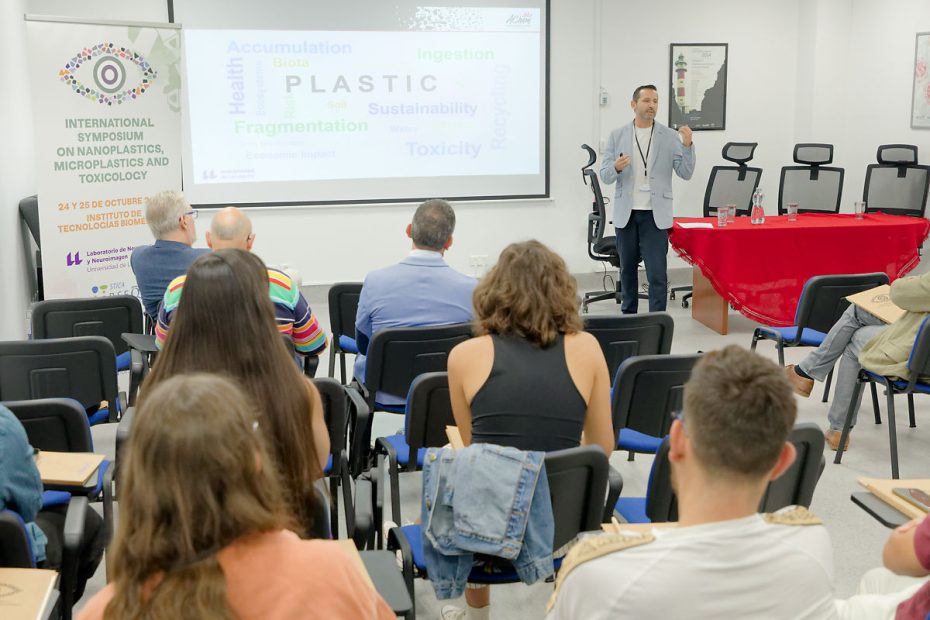The Faculty of Health Sciences of the University of La Laguna has organized the International Seminar on nanoplastics, microplastics and toxicology, which was inaugurated today, Thursday, October 24 and will run until tomorrow, Friday the 25th, at the Institute of Biomedical Technologies (ITB), with the participation of researchers from various disciplines, who will address the growing problem of the proliferation of these wastes in nature, whose effects on human beings are still unclear.
The seminar has been financed by the Vice-Rector’s Office for Research and Transfer, organized by the professor of Physiology José Luis González Mora and the researcher Soledad Carinelli. During the presentation, the first of them pointed out that this is a relatively new issue, which is why there are not many specialists available yet. Although it is not known exactly what their effects on health may be, it is evident that there is a need to be careful with these toxins and continue delving into their research, because once there is clinical evidence, that is when specific policies and actions can be formulated. , and carry out campaigns to raise awareness among the population about this danger.

Jose Luis González Mora, José Luis Pais and Soledad Carinelli.
The dean of the Faculty of Health Sciences, José Luis Pais, pointed out the opportunity for this forum to be held at the ITB, which is one of the research infrastructures that the center has, to address an issue about which there is still There is little scientific evidence. He highlighted the team of specialists from institutions such as Imperial College of London and the universities of Las Palmas de Gran Canaria, Politécnica de Cartagena and Alcalá, in addition to La Laguna itself, and pointed out that this type of meetings can be an incentive for young researchers decide to dedicate themselves to these newest issues.
General overview of microplastics
The first speaker of the day was the professor of Analytical Chemistry Javier Hernández Borges, who has been researching microplastics in the Canary Islands for about six years through the research group he coordinates, Applied Analytical Chemistry (AChem) and is one of the pioneers in the approach. of that matter at the national level. Their role in the seminar has been to offer a general overview of what this plastic waste is, its main characteristics and how they approach their research from their discipline.
The main environmental problem with plastics is that they are waste that is difficult to eliminate because it is a good material from an industrial point of view, being very resistant and malleable. When their size ranges between 5 millimeters and a micron, we speak of microplastics, and when they are less than a micron, and therefore impossible to see without the help of specific instruments, we speak of nanoplastics.
It is a polluting material because, in addition to the plastic itself, other substances are usually added to its composition with the aim of acquiring properties, such as plasticizers to give them shape, protectors against light or colorants, which also affect the environment. when they become waste.
Hernández Borges made a historical overview of the origin of plastic, starting from Bakelite in 1907. Starting in the 1950s last year, it experienced an explosion until reaching the current 400 million tons, a figure that is also growing. Since the 1970s there have been scientific articles warning about its danger, but they had little impact, partly due to pressure from the plastics industry. However, in 2004 Richard Thompson published the article in Science that revived interest in this subject, to the point that, currently, about 5,000 papers on the subject are published each year.
The speaker pointed out that there is already evidence of the presence of microplastics in all environmental compartments: water, soil and air, also reaching animals and vegetation. He pointed out, for example, that there is a greater presence of these pollutants in urban spaces than in rural ones, and that the incidence intensifies in closed spaces.
He also stopped to explain how they carry out their research, from taking samples on site to their analysis in the laboratory, and explained that one of the greatest difficulties in working is the creation of protocols to avoid contaminating the samples, something that is a brake. to move forward. For example, he specified that, at this time, his team is capable of analyzing samples of up to 50 microns because you cannot go to smaller measurements without seriously contaminating the object analyzed.
